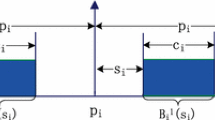Abstract
Although the earliest-deadline-first (EDF) policy is known to be optimal for preemptive real-time task scheduling in uniprocessor systems, the schedulability analysis problem has recently been shown to be \(\mathit{co}\mathcal{NP}\)-hard. Therefore, approximation algorithms, and in particular, approximations based on resource augmentation have attracted a lot of attention for both uniprocessor and multiprocessor systems. Resource augmentation based approximations assume a certain speedup of the processor(s). Using the notion of approximate demand bound function (dbf), in this paper we show that for uniprocessor systems the resource augmentation factor is at most \(\frac{2e-1}{e} \approx1.6322\), where e is the Euler number. We approximate the dbf using a linear approximation when the analysis interval length of interest is larger than the relative deadline of the task. For identical multiprocessor systems with M processors and constrained-deadline task sets, we show that the deadline-monotonic partitioning (that has been proposed by Baruah and Fisher) with the approximate dbf leads to an approximation factor of \(\frac{3e-1}{e}-\frac{1}{M} \approx 2.6322-\frac{1}{M}\) with respect to resource augmentation. We also show that the corresponding factor is \(3-\frac{1}{M}\) for arbitrary-deadline task sets. The best known results so far were \(3-\frac{1}{M}\) for constrained-deadline tasks and \(4-\frac {2}{M}\) for arbitrary-deadline ones. Our tighter analysis exploits the structure of the approximate dbf directly and uses the processor utilization violations (which were ignored in all previous analysis) for analyzing resource augmentation factors. We also provide concrete input instances to show that the lower bound on the resource augmentation factor for uniprocessor systems—using the above approximate dbf—is 1.5, and the corresponding bound is 2.5 for identical multiprocessor systems with an arbitrary order of fitting and a large number of processors. Further, we also provide a polynomial-time approximation scheme (PTAS) to derive near-optimal solutions under the assumption that the ratio of the maximum relative deadline to the minimum relative deadline of tasks is a constant, which is a more relaxed assumption compared to the assumptions required for deriving such a PTAS in the past.






Similar content being viewed by others
Notes
This is simply for the ease of presentation. The formation of clusters can be easily adjusted.
References
Albers K, Slomka F (2004) An event stream driven approximation for the analysis of real-time systems. In: ECRTS, pp 187–195
Albers K, Slomka F (2005) Efficient feasibility analysis for real-time systems with EDF scheduling. In: DATE, pp 492–497
Baruah S (2011) The partitioned EDF scheduling of sporadic task systems. In: Real-time systems symposium (RTSS), pp 116–125
Baruah S (2013) Partitioning sporadic task systems upon memory-constrained multiprocessors. ACM Trans Embed Comput Syst 12(3):78
Baruah SK, Fisher N (2005) The partitioned multiprocessor scheduling of sporadic task systems. In: RTSS, pp 321–329
Baruah SK, Fisher N (2006) The partitioned multiprocessor scheduling of deadline-constrained sporadic task systems. IEEE Trans Comput 55(7):918–923
Baruah SK, Mok AK, Rosier LE (1990) Preemptively scheduling hard-real-time sporadic tasks on one processor. In: IEEE real-time systems symposium, pp 182–190
Bonifaci V, Wiese A (2012) Scheduling unrelated machines of few different types. In: First interdisciplinary workshop on algorithmic challenges in real-time systems
Bonifaci V, Marchetti-Spaccamela A, Stiller S (2008) A constant-approximate feasibility test for multiprocessor real-time scheduling. In: ESA, pp 210–221
Bonifaci V, Chan H-L, Marchetti-Spaccamela A, Megow N (2010) Algorithms and complexity for periodic real-time scheduling. In: SODA, pp 1350–1359
Chakraborty S, Künzli S, Thiele L (2002) Approximate schedulability analysis. In: IEEE real-time systems symposium, pp 159–168
Chekuri C, Khanna S (2004) On multidimensional packing problems. SIAM J Comput 33(4):837–851
Davis RI, Burns A (2011) A survey of hard real-time scheduling for multiprocessor systems. ACM Comput Surv 43(4):35
Eisenbrand F, RothvoßT (2010) EDF-schedulability of synchronous periodic task systems is coNP-hard. In: SODA, pp 1029–1034
Fisher NW (2009) How hard is partitioning for the sporadic task model? In: Proceedings of the 2009 international conference on parallel processing workshops, ICPPW’09, pp 2–5
Garey MR, Johnson DS (1979) Computers and intractability: a guide to the theory of NP-completeness. Freeman, New York
Graham RL (1969) Bounds on multiprocessing timing anomalies. SIAM J Appl Math 17(2):416–429
Guan N, Stigge M, Yi W, Yu G (2010) Fixed-priority multiprocessor scheduling with Liu and Layland’s utilization bound. In: IEEE real-time and embedded technology and applications symposium, pp 165–174
Hochbaum DS, Shmoys DB (1987) Using dual approximation algorithms for scheduling problems theoretical and practical results. J ACM 34(1):144–162
Liu CL, Layland JW (1973) Scheduling algorithms for multiprogramming in a hard-real-time environment. J ACM 20(1):46–61
Mok AK (1983) Fundamental design problems of distributed systems for the hard-real-time environment. Technical report Cambridge, MA, USA
Acknowledgements
This work was partially supported by Baden Württemberg MWK Juniorprofessoren-Programms. We also thank the anonymous reviewers for their valuable feedback in helping improve this paper.
Author information
Authors and Affiliations
Corresponding author
Appendix
Appendix
Proof of Inequality >∗ in (33)
If \(\frac{1}{\beta}+\frac{1}{|\mathbf{M}_{1}|}-1 < 0\), then we know that

For the rest, we consider \(\frac{1}{\beta}+\frac{1}{|\mathbf{M}_{1}|}-1 \geq0\). The infimum for
happens when k is equal to \(\beta-1+\frac{1}{1+x}\). Therefore,

When k equals to \(\frac{(1+\frac{\beta}{|\mathbf{M}_{1}|})(2x+1)-(x^{2}+x)(1+\beta)}{(1+x)^{2}}\), the infimum for
happens. Therefore, we have

□
Rights and permissions
About this article
Cite this article
Chen, JJ., Chakraborty, S. Resource augmentation for uniprocessor and multiprocessor partitioned scheduling of sporadic real-time tasks. Real-Time Syst 49, 475–516 (2013). https://doi.org/10.1007/s11241-013-9181-5
Published:
Issue Date:
DOI: https://doi.org/10.1007/s11241-013-9181-5




